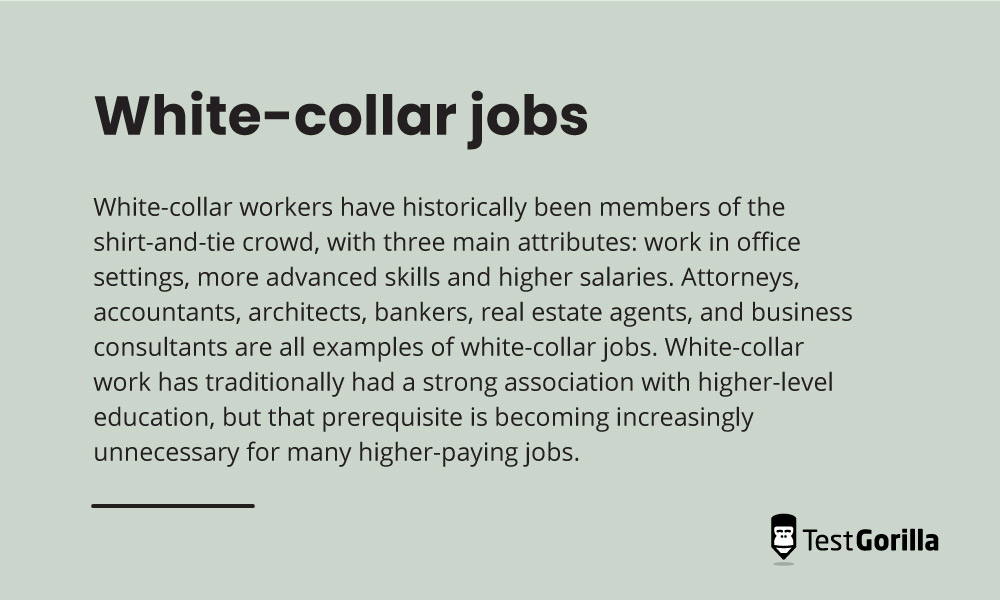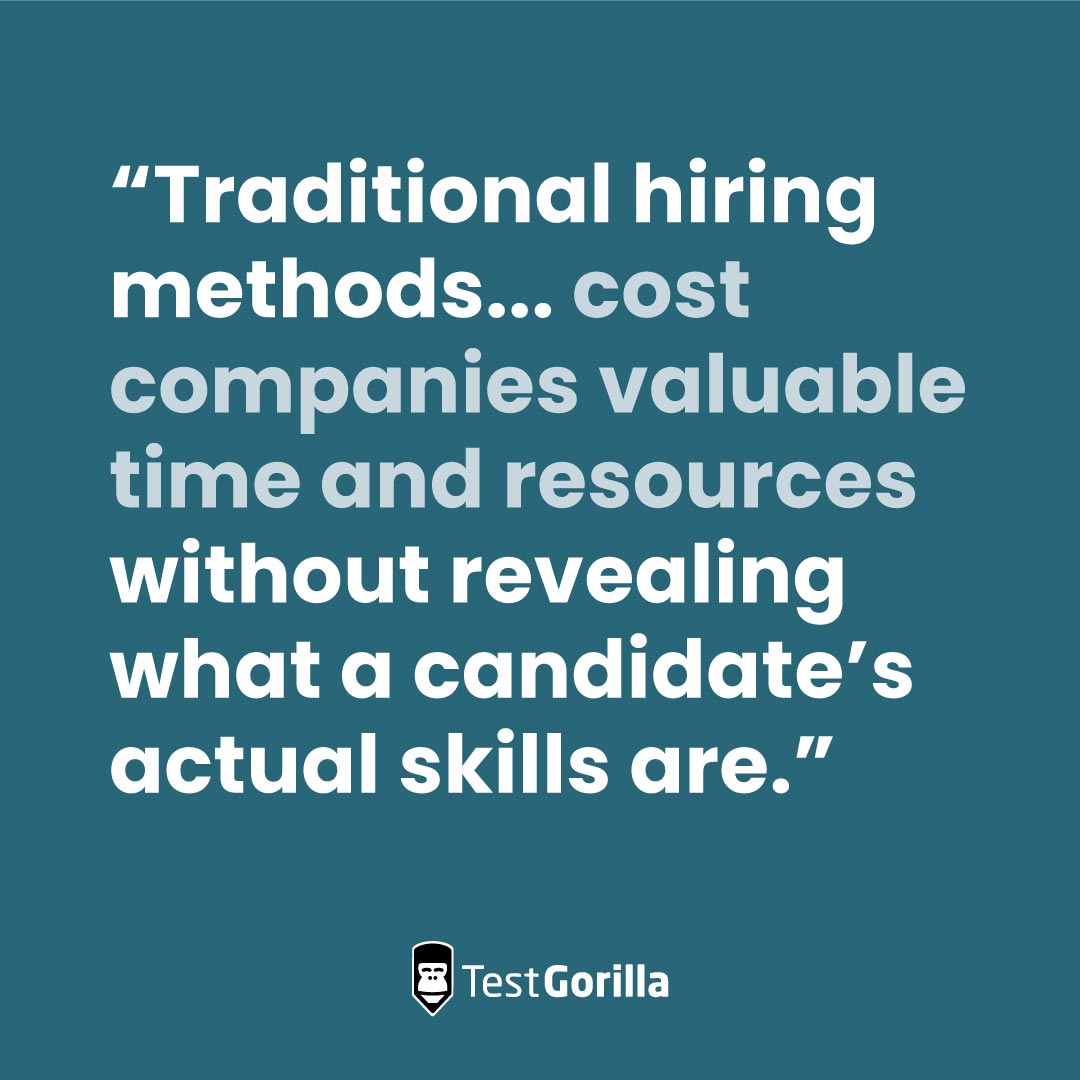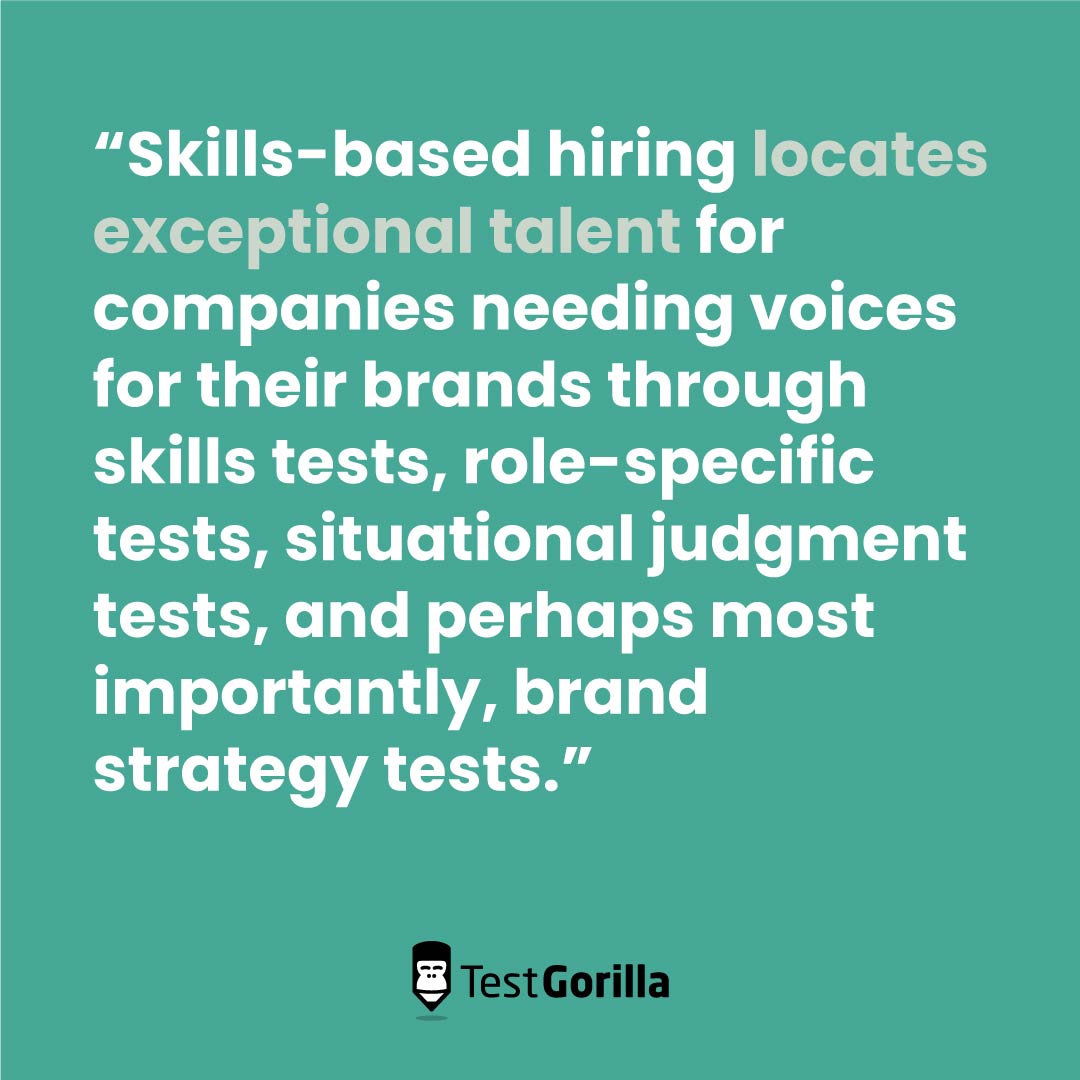How to recruit for white-collar jobs using skills-based hiring
White-collar jobs can be really difficult to hire for because the roles and responsibilities of white-collar workers are often a blend of high-level hard and soft skills and experience. This makes tasks and roles can be hard to define.
Traditional hiring practices seem to ignore this crucial question by gathering the fluid work responsibilities of white-collar jobs into singular job titles and organizational hierarchies. In other words, they use blue-collar hiring practices for white-collar jobs.
With rapid ongoing changes in technology, consumer behaviors, and employee demands, this overly simplistic view of white-collar work compromises organizational agility, growth, innovation, diversity, and a positive employee experience.[1]
On the other hand, adopting skills-based hiring practices and working models caters to the fluid responsibilities and requirements of white-collar work by centering skills over degrees, resumes, and cover letters during the hiring process.
Let’s take a look at the skills necessary for such jobs before diving into six examples of white-collar jobs and how to hire for them.
Table of contents
What are white-collar jobs, exactly?
Before taking a look at how skills-based hiring can positively impact the white-collar job market, let’s examine what we actually mean when we say “white-collar.”
White-collar workers have historically been members of the shirt-and-tie crowd, with three main attributes:
Work in office settings
More advanced skills
Higher salaries
Attorneys, accountants, architects, bank tellers, real estate agents, and business consultants are all examples of white-collar jobs.
White-collar work has traditionally had a strong association with higher-level education, but that prerequisite is becoming increasingly unnecessary for many higher-paying jobs.
Other types of collars
Other "collared" labels for jobs, which are used to varying degrees of popularity, include the following:
Blue-collar job: a blue-collar job typically requires manual labor. They tend to be lower paid compared to white-collar jobs, are associated with the working class, and are usually paid hourly.
Red-collar job: a red-collar job describes a position working in government or civil service. In the US, government employees receive compensation from the 'red ink' budget, hence the nickname.
Yellow-collar job: a yellow-collar job refers to a profession within a creative industry or sector, for example, a filmmaker.
Open-collar job: the open-collar term has emerged recently to describe jobs done by people who work from home, usually via the internet.
Brown-collar job: brown-collar work refers to jobs in military services such as the army.
Green-collar job: green-collar jobs refer to any kind of employment in the environmental sector.
5 foundational skills for white-collar workers
Although there are many white-collar jobs that require skills unique to their specific industry, there are several foundational skills workers tend to need in order to succeed in higher-paying roles, including but not limited to:
IT skills
Public speaking skills
Organization and time-management skills
Writing skills
Logical thinking skills
These skills are integral to most, if not all, white-collar work and can easily be measured using a relevant skills test.
1. IT skills
It should come as no surprise that white-collar jobs rely heavily on computer technology to communicate and accomplish a wide variety of tasks. More broadly, digital literacy has become a non-negotiable for the white-collar workplace.
Being up to date with the latest software and solutions relevant to a particular field is a cornerstone of white-collar work. Proficiency with platforms like MS Office, Excel, Google Sheets, PowerPoint, and familiarity with role-specific content management systems have all become basic IT skills requirements for white-collar jobs.
2. Public speaking skills
A significant amount of white-collar jobs require collaboration, teamwork, and presentations to effectively communicate different stages of projects as well as projections for the future of a business.
At the heart of these responsibilities is the skill of public speaking: being able to get up in front of a group of peers and superiors and speak knowledgeably and coherently about a range of topics.
In fact, this skill can play a major role in an employee’s promotion, helping them stand out from the competition.
3. Organization and time-management skills
White-collar workers must be able to juggle multiple responsibilities at once without missing deadlines or obstructing workflows.
These requirements are not unique to white-collar work, but the mastery of digital tools to save time and execute various competing tasks drives success in white-collar positions.
4. Writing skills
At many high-paying jobs, the bulk of communication is done through writing.
Employees with strong writing skills offer many practical benefits to their employers:
Faster and more effective communication across teams and departments
Fewer misunderstandings and chances for workplace conflict to arise
More credibility in the eyes of customers
Stronger standard operating practices and procedures
Contrary to popular opinion, you don’t need a college degree to become a good writer. There are heaps of online courses, mentorship programs, and in-person writing workshops that can help workers improve their writing skills.[2]
5. Logical thinking skills
Critical thinking skills enable employees to confront problems with actionable solutions that are developed through critical reasoning and reflection.
Again, these skills are not solely found in white-collar spaces, but they’re required in any position where an employee faces multiple problems, questions, or objectives and must rely on their problem-solving and intuitive thinking to succeed.
How do I hire white-collar workers?
Now that we know what white-collar jobs are, the question is this: how should employers go about hiring white-collar workers?
When it comes to white-collar recruitment, resumes won't cut it
To put it simply, traditional hiring methods don't do a good job of assessing candidates for the skills mentioned above.
Traditional hiring methods such as resumes and cover letters exaggerate the worth of degrees, prioritize like-minded or culturally homogenous job candidates, and implement multiple rounds of unstructured interviews. This costs companies valuable time and resources without revealing what a candidate’s actual skills are.
To be clear, degrees provide opportunities to learn the skills that white-collar jobs require, but they are certainly not the only vehicle for learning those skills. In fact, employers now often demand degrees for jobs that didn’t previously require them, a phenomenon known as “degree inflation” – and the main culprit behind the paper ceiling.
Degrees are used as proxies for hard and soft skills with the assumption that if someone went to college, they probably know how to speak in public, write well, or have digital literacy. But the truth is, degrees don’t accurately demonstrate any of these proficiencies. Instead, they serve to exclude degree-less candidates who may actually have the necessary skills for many available white-collar jobs.
A review of white-collar employment data from the U.S. Equal Employment Opportunity Commission reveals serious gaps in income, promotional opportunities, and advancement for minorities and women of all races. – Michael Gee (2018), 'Why aren't Black employees getting more white-collar jobs?
Skills-based hiring identifies diverse white-collar talent
As long as employers hire for white-collar jobs using resumes, the sector's diversity problems will persist. The solution? Hire white-collar workers based on skills.
Hiring for skills instead of educational history widens the talent pool and promotes equality of opportunity: in fact, key statistics from our 2023 skills-based hiring report show that:
75% of Black employees gained access to employment opportunities through skills-based hiring
73% of Asian and Arab employees gained access to employment opportunities through skills-based hiring
Our 2024 report shows that, overall, 90% of employers using skills-based hiring improved workplace diversity
What's more, hiring for skills is actually cheaper in the long run, even when companies invest in training, upskilling, and free education for their employees.
Amazon, for example, is investing more than $1.2bn to provide skills training and free education to more than 300,000 employees in the U.S. to grab opportunities in increasingly white-collar jobs.
Investing in skills training and adopting skills-based hiring removes the barrier between effective candidates and open positions in traditionally white-collar industries. Hiring candidates who have relevant skills and nurturing their development empowers businesses to retain employees while increasing productivity, innovation, and job satisfaction.
Skills-based hiring also reduces the differences between white-collar vs. blue-collar recruitment, so it works no matter what type of worker you’re looking for.
The State of Skills-Based Hiring 2024
Read TestGorilla's annual report to discover why over 81% of companies are choosing to adopt skills-based hiring methods in 2024.
6 examples of white-collar jobs (and how to hire for them)
Next, let’s take a look at a few of these white-collar jobs that can be filled effectively by hiring for skills instead of degrees.
1. Medical and health services manager
A medical and health services manager plans, directs, and coordinates the business activities of healthcare providers. They can work in offices, hospitals, nursing homes, medical practices, and other healthcare facilities.
Typically, medical and health services managers must have a four-year college degree and a master’s degree, with additional license requirements varying by state.
It is easy to write off this position as degree-or-bust because of its relationship to the medical field, but when taking a closer look at the common experience and skills required, there is plenty of room for candidates without degrees to perform in this role.
Medical and health services managers:
Are highly organized professionals
Are detail-oriented
Have great logical and analytical skills
Use excellent communication skills to interface with many different caregivers, doctors, nurses, health insurance representatives, and administrators
The hard skills required for this type of position are related to the specific technology that a hospital or healthcare facility uses, which candidates should have a working knowledge of. Since these managers do not interact with patients or engage in clinical work, they rely heavily on soft skills such as decision-making and leadership capabilities.
With a skills-based hiring approach, employers could assess candidates who may not have a specific degree but who have experience in healthcare environments, finance and leadership roles, or a strong aptitude for administrative technology platforms.
Situational judgment tests, for example, can help employers assess a candidate’s ability to navigate complex business situations that may develop in the healthcare marketplace, which would fall within the purview of a medical and health services manager. These tests also measure a candidate’s ability to negotiate, lead, and manage other workers in fast-paced, stressful environments like hospitals or urgent care units.
There are also role-specific tests that can be used to assess a candidate’s understanding of health information systems, medical terminology, hospital organization, accounting budgeting, or healthcare law, which correspond to skills and information that could be acquired outside of a college environment.
Would a college graduate make a better medical and health services manager than someone without a degree? Not necessarily, if the latter had more experience in these environments and could better demonstrate the skills required to perform in the role.
2. Information security analyst
Information security analysts typically work in IT departments to implement security measures for an organization’s network and computer systems.
They can work for computer companies, consulting firms, or financial companies to maintain security through encryption, firewall software, compliance control, training, and more.
Candidates for this white-collar job need:
Strong analytical skills
In-depth knowledge of computer networks and digital systems
Excellent troubleshooting and problem-solving skills
They are detail-oriented professionals who can identify small changes in a system’s defense and performance, while properly diagnosing issues that could cause major damage to a company down the road.
Although a college degree may help a candidate stand out within a traditional hiring process, they still need to be able to clearly demonstrate these hard, technical skills, as well as soft skills like logical thinking, writing, public speaking, and more, to be able to perform well in the role.
Skills-based hiring can quickly determine whether a candidate is right for this role with a software skills test that assesses a candidate’s performance on different software solutions, security programs, and analytics platforms, like Google Analytics, for example.
3. Programmer
Computer programmers write, modify, and test code in addition to scripts that allow computers to function properly.
Similar to information security analysts, programmers spend a lot of time working with software, but they are more geared toward designing systems that can be used across different industries. Degrees are typically required but are by no means the only indicator of the skills required for the job.
Programmers must have the following hard and soft skills:
Hard skills:
Data structures and algorithms
Web development
Cloud computing
Containers
Object-oriented programming
Integrated development environments, and more
Soft skills:
Communication (verbal and written)
Organization and time-management
Empathy
Logical and problem-solving skills
Adaptability
If employers only focus on programmers with degrees, they miss out on a huge swath of the talent pool.
As of 2022, nearly 35% of software developers received no formal college or university training. Instead, they chose to self-learn through boot camps, industry certification programs, or workshops.
A skills-based hiring approach rewards these candidates with white-collar jobs, not because of their connections or educational history, but because of their demonstrable ability to execute the responsibilities of the job. An added benefit is their genuine desire to learn and grow within the field.
How does skills-based hiring help? Employers can design their own coding tests that accommodate industry or company-specific platforms that they want their information security analysts to be familiar with. They can also account for a programmer’s behavioral fit with behavioral assessments and structured interviews.
4. Brand Manager
Brand managers build brand strategy by overseeing any aspect of marketing that relates to the company’s products and services to attract customers and increase profits.
Brand managers have a lot of different responsibilities, such as:
Market research
Project management
Budget management
Maintaining relationships with different company stakeholders
Advising multiple teams on strategy
Working across departments to reinforce brand strategy
As we have seen with other white-collar jobs, a degree is often required to be considered for this role. But when looking at the specific skills required, there’s no need for a company to keep a tight lid on its talent pool.
Working across departments and acting as the brand voice for a company means that brand managers must have excellent communication skills, including impeccable written and verbal skills.
They must also have great research skills to inform the marketing and budgeting decisions they have to make regularly. A basic understanding of data analytics is strongly preferred to have a firm grasp of where a company’s brand can succeed.
Creativity is a huge skill that a degree alone cannot prove, and it is the primary requirement for a brand manager role. Skills-based hiring locates exceptional talent for companies needing voices for their brands through skills tests, role-specific tests, situational judgment tests, and perhaps most importantly, brand strategy tests.
The Branding Strategy test evaluates a candidate’s ability to define, position, manage and develop a brand. A brand manager needs to have a strong understanding of the company culture and the potential to add to that culture, which is why culture-add tests can also be a great hiring tool.
5. Sales representative
Sales representatives sell products or services for a business and act as an external representation of that company’s brand.
In a largely performance-driven field, sales representatives earn based on their ability to form and maintain professional relationships, identify and address customer needs, and pitch prospects on what they are offering in order to close sales.
Becoming a successful sales representative requires a set of skills that are by no means limited to a college education.
Sure, a degree in business or communications can definitely supply candidates with the skills and information required to become a great sales rep, but the following necessary skills can be acquired outside of a university setting:
Customer service
Negotiation
Product knowledge
Self-confidence
Client relationships
Motivation
Closing skills
Marketing skills
Presentation and communication skills
Skills-based hiring measures these competencies through behavioral interviews to identify important soft skills, personality and culture-add tests, and even language tests if your candidate and/or customer base are not from an English-speaking background.
Just because someone has an impressive educational background, doesn’t mean they can sell a product. That’s a skill that needs to be proven.
6. Graphic designer
Graphic designers make visuals for all kinds of projects, like eBook illustrations, print and web ads, email campaigns, magazines, video games, television and film, and many others.
Graphic designers blend artistic and technological skills to deliver visual assets to a variety of businesses and stakeholders.
Although many companies require degrees from universities with top design programs, the principles of design as well as the specific platforms required to do the work can all be learned online through virtual classes, workshops, boot camps, and free tutorials on YouTube or private sites.
Similar to the brand manager role, graphic designers rely on their creativity and attention to detail to succeed. Digital literacy and competencies with software tools like Photoshop, Adobe Illustrator, Figma, and others, are all a must for graphic designers.
If an employer believes it’s easier, cheaper, and more effective to limit the talent pool to those with degrees, they miss out on a huge range of creative talent. University design programs can be an incredible resource for graphic designers and aspiring artists, but there are countless other ways to develop artistic skills outside of the classroom.
You can use the following to determine if a candidate is right for the design job:
Skills assessments, like our Adobe Photoshop test, to assess software proficiency
Culture-add tests to gauge personality and value fit
Role-specific tests to assess their design skills
Behavioral interviews to determine how well they would work with your current team
Focus on skills for white-collar recruitment
These are only a handful of the many white-collar jobs that can be filled with skills-based hiring.
In addition to speeding up the hiring process, cutting costs, and locating top-tier talent, skills-based hiring also removes the barrier that degrees create between qualified candidates and good jobs that need to be filled.
Employers can use tools like skills assessment tests, situational judgment tests, and behavioral interviews to accurately predict job performance for white-collar roles.
By focusing on the skills that jobs require rather than what their traditional titles suggest, organizations introduce a flood of diverse, qualified workers into their operations to adapt to an ever-changing market.
For more information, learn how skills-based hiring regularly delivers better candidates for any position, including white-collar jobs. Alternatively, if you're ready to hire for your next white-collar job, try our Critical Thinking test to assess a candidate’s ability to make judgments or invent solutions.
Sources
Cantrell, Sue, et al. (September 8, 2022). “The skills-based organization: A new operating model for work and the workforce”. Deloitte Insights. Retrieved March 20th, 2023. https://www2.deloitte.com/us/en/insights/topics/talent/organizational-skill-based-hiring.html
Meyer, Fred, et al. (n.d.). “Our Philosophy: Writing Classes Should Be Affordable and Amazing”. Writers.com. Retrieved March 20th, 2023.
Related posts
You've scrolled this far
Why not try TestGorilla for free, and see what happens when you put skills first.
Latest posts
The best insights on HR and recruitment, delivered to your inbox.
Biweekly updates. No spam. Unsubscribe any time.

Skills tests to hire the best
Our screening tests identify the best candidates and make your hiring decisions faster, easier, and bias-free.
Free resources
A step-by-step blueprint that will help you maximize the benefits of skills-based hiring from faster time-to-hire to improved employee retention.
With our onboarding email templates, you'll reduce first-day jitters, boost confidence, and create a seamless experience for your new hires.
This handbook provides actionable insights, use cases, data, and tools to help you implement skills-based hiring for optimal success
A comprehensive guide packed with detailed strategies, timelines, and best practices — to help you build a seamless onboarding plan.
This in-depth guide includes tools, metrics, and a step-by-step plan for tracking and boosting your recruitment ROI.
Get all the essentials of HR in one place! This cheat sheet covers KPIs, roles, talent acquisition, compliance, performance management, and more to boost your HR expertise.
Onboarding employees can be a challenge. This checklist provides detailed best practices broken down by days, weeks, and months after joining.
Track all the critical calculations that contribute to your recruitment process and find out how to optimize them with this cheat sheet.


















